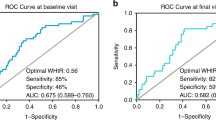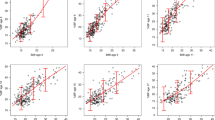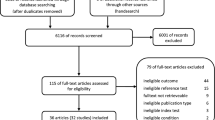Abstract
Background
There are limited data comparing the relative associations of various BMI metrics with adiposity and cardiometabolic risk factors in youth.
Objective
Examine correlations of 7 different BMI metrics with adiposity, cardiometabolic risk factors, and biomarkers (i.e. blood pressure, waist circumference, cholesterol, leptin, insulin, high molecular weight adiponectin, high-sensitivity c-reactive protein (hsCRP)).
Methods
This was a cross-sectional analysis of youth in all BMI categories. BMI metrics: BMI z-score (BMIz), extended BMIz (ext.BMIz), BMI percentile (BMIp), percent of the BMI 95th percentile (%BMIp95), percent of the BMI median (%BMIp50), triponderal mass index (TMI), and BMI (BMI). Correlations between these BMI metrics and adiposity, visceral adiposity, cardiometabolic risk factors and biomarkers were summarized using Pearson’s correlations.
Results
Data from 371 children and adolescents ages 8–21 years old were included in our analysis: 52% were female; 20.2% with Class I obesity, 20.5% with Class II, and 14.3% with Class III obesity. BMIp consistently demonstrated lower correlations with adiposity, risk factors, and biomarkers (r = 0.190–0.768) than other BMI metrics. The %BMIp95 and %BMIp50 were marginally more strongly correlated with measures of adiposity as compared to other BMI metrics. The ext.BMIz did not meaningfully outperform BMIz.
Conclusion
Out of all the BMI metrics evaluated, %BMIp95 and %BMIp50 were the most strongly correlated with measures of adiposity. %BMIp95 has the benefit of being used currently to define obesity and severe obesity in both clinical and research settings. BMIp consistently had the lowest correlations. Future research should evaluate the longitudinal stability of various BMI metrics and their relative associations with medium to long-term changes in adiposity and cardiometabolic outcomes in the context of intervention trials.
This is a preview of subscription content, access via your institution
Access options
Subscribe to this journal
Receive 12 print issues and online access
$259.00 per year
only $21.58 per issue
Buy this article
- Purchase on Springer Link
- Instant access to full article PDF
Prices may be subject to local taxes which are calculated during checkout



Similar content being viewed by others
References
Ryder JR, Kaizer AM, Rudser KD, Daniels SR, Kelly AS. Utility of body mass index in identifying excess adiposity in youth across the obesity spectrum. J Pediatr. 2016;177:255–61.e2.
Freedman DS, Wang J, Maynard LM, Thornton JC, Mei Z, Pierson RN, et al. Relation of BMI to fat and fat-free mass among children and adolescents. Int J Obes. 2005;29:1–8.
Harrington DM, Staiano AE, Broyles ST, Gupta AK, Katzmarzyk PT. BMI percentiles for the identification of abdominal obesity and metabolic risk in children and adolescents: evidence in support of the CDC 95th percentile. Eur J Clin Nutr. 2013;67:218–22.
Ebrahimi-Mamaeghani M, Mohammadi S, Arefhosseini SR, Fallah P, Bazi Z. Adiponectin as a potential biomarker of vascular disease. Vasc Health Risk Manag. 2015;11:55–70.
Hall JE, do Carmo JM, da Silva AA, Wang Z, Hall ME. Obesity, kidney dysfunction and hypertension: mechanistic links. Nat Rev Nephrol. 2019;15:367–85.
Kelly AS, Barlow SE, Rao G, Inge TH, Hayman LL, Steinberger J, et al. Severe obesity in children and adolescents: identification, associated health risks, and treatment approaches: a scientific statement from the American Heart Association. Circulation. 2013;128:1689–712.
Flegal KM, Wei R, Ogden CL, Freedman DS, Johnson CL, Curtin LR. Characterizing extreme values of body mass index-for-age by using the 2000 Centers for Disease Control and Prevention growth charts. Am J Clin Nutr. 2009;90:1314–20.
Freedman DS, Butte NF, Taveras EM, Goodman AB, Ogden CL, Blanck HM. The Limitations of Transforming Very High Body Mass Indexes into z-Scores among 8.7 Million 2- to 4-Year-Old Children. J Pediatr. 2017;188:50–6.e1.
Kuczmarski RJ, Ogden CL, Guo SS, Grummer-Strawn LM, Flegal KM.MeiZ, et al. CDC Growth Charts for the United States: methods and development. Vital Health Stat 11. 2000;246:1–190.
Flegal KM, Cole TJ. Construction of LMS parameters for the Centers for Disease Control and Prevention 2000 growth charts. Natl Health Stat Report. 2013;63:1–3.
Freedman DS, Butte NF, Taveras EM, Lundeen EA, Blanck HM, Goodman AB, et al. BMI z-Scores are a poor indicator of adiposity among 2- to 19-year-olds with very high BMIs, NHANES 1999-2000 to 2013-2014. Obesity. 2017;25:739–46.
Freedman DS, Berenson GS. Tracking of BMI z Scores for Severe Obesity. Pediatrics. 2017;140:e20171072.
Valerio G, Maffeis C, Balsamo A, Del Giudice EM, Brufani C, Grugni G, et al. Severe obesity and cardiometabolic risk in children: comparison from two international classification systems. PloS one. 2013;8:e83793.
Kakinami L, Henderson M, Chiolero A, Cole TJ, Paradis G. Identifying the best body mass index metric to assess adiposity change in children. Arch Dis Child. 2014;99:1020–4.
Peterson CM, Su H, Thomas DM, Heo M, Golnabi AH, Pietrobelli A, et al. Tri-Ponderal Mass Index vs Body Mass Index in Estimating Body Fat During Adolescence. JAMA Pediatrics. 2017;171:629–36.
Hales CM, Carroll MD, Fryar C, Ogden CL. Prevalence of Obesity and Severe Obesity Among Adults: United States, 2017-2018. NCHS Data Brief. 2020;360:1–8.
Wei R, Parsons V, Ogden CL, editors. Using a Half-Normal Distribution to Track Extreme BMI Values Among Youth. Joint Statistical Meeting 2019; Colorado Convention Center.
Fonseca FA, Izar MC. High-Sensitivity C-Reactive Protein and Cardiovascular Disease Across Countries and Ethnicities. Clinics. 2016;71:235–42.
Fyfe-Johnson AL, Ryder JR, Alonso A, MacLehose RF, Rudser KD, Fox CK, et al. Ideal Cardiovascular Health and Adiposity: Implications in Youth. J Am Heart Assoc. 2018;7:e007467.
Bosch TA, Dengel DR, Kelly AS, Sinaiko AR, Moran A, Steinberger J. Visceral adipose tissue measured by DXA correlates with measurement by CT and is associated with cardiometabolic risk factors in children. Pediatric Obes. 2015;10:172–9.
Ogden CL, Hales CM, Freedman DS, editors. ALTERNATIVES TO BMI Z-SCORES ABOVE THE 95TH PERCENTILE OF THE CDC GROWTH CHARTS. Las Vegas: Obesity Week; 2019.
Meng XRR, Rubin D. Comparing correlated correlation coefficients. Am Psychol Association. 1992;111:172–5.
Rosner B, Prineas RJ, Loggie JM, Daniels SR. Blood pressure nomograms for children and adolescents, by height, sex, and age, in the United States. J Pediatr. 1993;123:871–86.
Fletcher RS, Fisher DK. R: A language and environment for statistical computing. Vienna, Austria. 2019.
Bray GA. Medical consequences of obesity. J Clin Endocrinol Metab. 2004;89:2583–9.
Liu L, Feng J, Zhang G, Yuan X, Li F, Yang T, et al. Visceral adipose tissue is more strongly associated with insulin resistance than subcutaneous adipose tissue in Chinese subjects with pre-diabetes. Curr Med Res Opin. 2018;34:123–9.
Hawley PC, Hawley MP. Difficulties in diagnosing pulmonary embolism in the obese patient: a literature review. Vasc Med. 2011;16:444–51.
Freedman DS, Butte NF, Taveras EM, Goodman AB, Blanck HM. Longitudinal changes in BMI z-scores among 45 414 2-4-year olds with severe obesity. Ann Hum Biol. 2017;44:687–92.
Park HK, Shim YS. Distribution of Tri-Ponderal Mass Index and its Relation to Body Mass Index in Children and Adolescents Aged 10 to 20 Years. J Clin Endocrinol Metab. 2020;105:e826–e834.
Cleveland WS. Robust Locally Weighted Regression and Smoothing Scatterplots. J Am Stat Association. 1979;74:829–36.
Acknowledgements
The authors would like to acknowledge David Freedman, Ph.D., for his guidance and expertise in this work.
Funding
This work was supported by R01-HL110957 (ASK), and the National Center for Advancing Translational Sciences of the National Institutes of Health Award Number UL1TR000114. CTB was funded by the National Institutes of Health’s National Center for Advancing Translational Sciences, grants KL2TR002492 and UL1TR002494. The content is solely the responsibility of the authors and does not necessarily represent the official views of the National Institutes of Health’s National Center for Advancing Translational Sciences.
Author information
Authors and Affiliations
Corresponding author
Ethics declarations
Competing interests
JRR receives donated drug/placebo from Boehringer Ingelheim for a clinical trial. CKF receives research support from Rhythm Pharmaceuticals and Novo Nordisk. EMB is a site principal investigator for Novo Nordisk. ASK serves as an unpaid consultant for Novo Nordisk, Vivus, and WW (formerly Weight Watchers) and receives donated drug/placebo from Astra Zeneca for an NIDDK-funded clinical trial.
Additional information
Publisher’s note Springer Nature remains neutral with regard to jurisdictional claims in published maps and institutional affiliations.
Supplementary information
Rights and permissions
About this article
Cite this article
Bramante, C.T., Palzer, E.F., Rudser, K.D. et al. BMI metrics and their association with adiposity, cardiometabolic risk factors, and biomarkers in children and adolescents. Int J Obes 46, 359–365 (2022). https://doi.org/10.1038/s41366-021-01006-x
Received:
Revised:
Accepted:
Published:
Issue Date:
DOI: https://doi.org/10.1038/s41366-021-01006-x
This article is cited by
-
The effect of parental diabetes prevention program participation on weight loss in dependent children: a prospective cohort study
Clinical Diabetes and Endocrinology (2023)
-
Longitudinal multi-omics study reveals common etiology underlying association between plasma proteome and BMI trajectories in adolescent and young adult twins
BMC Medicine (2023)
-
Lower adiponectin is associated with higher anthropometry and insulin resistance but not with low cardiorespiratory fitness in adolescents
Journal of Endocrinological Investigation (2023)
-
Fat-free mass index is a feasible predictor of insulin resistance in women with polycystic ovary syndrome: Evidence from a cross-sectional study
Endocrine (2023)



